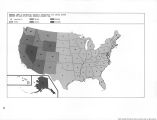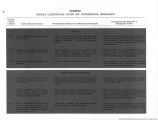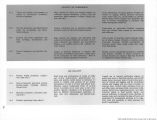| OCR Text |
Show an effective role in Federal agency land use planning. Federal land use plans should be developed in consultation with these governments, circulated to them for comments, and should conform to state or local zoning to the maximum extent feasible. As a general rule, no use of public land should be permitted which is prohibited by state or local zoning. Page 61. 14. Congress should provide additional financial assistance to public land states to facilitate better and more comprehensive land use planning. Page 63. 15. Comprehensive land use planning should be encouraged through regional commissions along the lines of the river basin commissions created under the Water Resources Planning Act of 1965. Such commissions should come into existence only with the consent of the states involved, with regional coordination being initiated when possible within the context of existing state and local political boundaries. Page 64. Chapter Four {Public Land Policy and the Environment) : 16. Environmental quality should be recognized by law as an important objective of public land management, and public land policy should be designed to enhance and maintain a high quality environment both on and off the public lands. Page 68. 17. Federal standards for environmental quality should be established for public lands to the extent possible, except that, where state standards have been adopted under Federal law, state standards should be utilized. Page 70. 18. Congress should require classification of the public lands for environmental quality and enhancement and maintenance. Page 73. 19. Congress should specify the kinds of environmental factors to be considered in land use planning and decisionmaking, and require the agencies to indicate clearly how they were taken into account. Page 77. 20. Congress should provide for greater use of studies of environmental impacts as a precondition to certain kinds of uses. Page 80. 21. Existing research programs related to the public lands should be expanded for greater emphasis on environmental quality. Page 80. 22. Public hearings with respect to environmental 'considerations should be mandatory on proposed public land projects or decisions when requested by the states or by the Council on Environmental Quality. Page 81. 23. Congress should authorize and require the public land agencies to condition the granting of rights or privileges to the public lands or their resources on compliance with applicable environmental control measures governing operations off public 10 lands which are closely related to the right or privilege granted. Page 81. 24. Federal land administering agencies should be authorized to protect the public land environment by (1) imposing protective covenants in disposals of public lands, and (2) acquiring easements on non-Federal lands adjacent to public lands. Page 82. 25. Those who use the public lands and resources should, in each instance, be required by statute to conduct their activities in a manner that avoids or minimizes adverse environmental impacts, and should be responsible for restoring areas to an acceptable standard where their use has an adverse impact on the environment. Page 83. 26. Public land areas in need of environmental rehabilitation should be inventoried and the Federal Government should undertake such rehabilitation. Funds should be appropriated as soon as practical for environmental management and rehabilitation research. Page 86. 27. Congress should provide for the creation and preservation of a natural area system for scientific and educational purposes. Page 87. Chapter Five {Timber Resources): 28. There should be a statutory requirement that those public lands that are highly productive for timber be classified for commercial timber production as the dominant use, consistent with the Commission's concept of how multiple use should be applied in practice. Page 92. 29. Federal programs on timber production units should be financed by appropriations from a revolving fund made up of receipts from timber sales on these units. Financing for development and use of public forest lands, other than those classified for timber production as the dominant use, would be by appropriation of funds unrelated to receipts from the sale of timber. Page 95. 30. Dominant timber production units should be managed primarily on the basis of economic factors so as to maximize net returns to the Federal Treasury. Such factors should also play an important but not primary role in timber management on other public lands. Page 96. 31. Major timber management decisions, including allowable-cut determinations, should include specific consideration of economic factors. Page 97. 32. Timber sales procedures should be simplified wherever possible. Page 98. 33. There should be an accelerated program of timber access road construction. Page 99. 34. Communities and firms dependent on public land timber should be given consideration in the management and disposal of public land timber. Page 99. 35. Timber production should not be used as a |







































































































































































































































































































































































